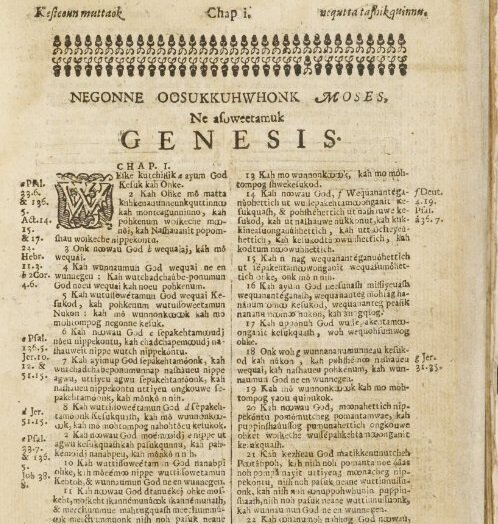
Rev. Daniel Takawampbait (c1654-1716) was a central figure in the religious life of Natick, leading the Christian fellowship and the Natick church in the years after the death of John Eliot.
Takawampbait: Second Ordained Minister of the Natick Church
The Takawambpait desk is on display in the Natick Historical Society
Rev. Daniel Takawambpait (c. 1654-1716) was a central figure in Natick's religious life. He led the Christian fellowship in Natick’s church years after the death of Puritan English missionary Rev. John Eliot (1604-1690). Takawampbait ministered to the church at the end of the 17th century, when Natick had about 180 residents and ten recognized church members.
Takawampbait’s life and ministry are not well documented, although he was a community leader, a prestigious teacher, and later a minister. He may have attended the Indian College established at Harvard University in 1636. Takawampbait likely worked alongside John Eliot and Daniel Gookin to write The Dying Speeches of Several Indians, collecting the speeches of his neighbors in their original Algonquian language. In the 1680s, Eliot ordained Takawampbait as New England's first Indigenous Puritan minister.
Takawampbait’s headstone, now on the front lawn of the Eliot Church in South Natick
The inscription reads:
Here lyes the
body of Daniel
Takawampbait
Aged 64 years
Died September
the 17th, 1716
When the deadly violence of King Philip’s War (1675-1676) devastated New England, English settlers began to question the loyalties of Praying Town residents, although most were allied with the English. The Massachusetts General Court interned residents of Natick and other “Praying Indians” on Deer Island in Boston Harbor through a harsh winter. Many of them were left there to die without food and water. When spring arrived, the Massachusetts General Court eventually freed them. It is said that Waban, one of the political leaders of seventeenth-century Natick, initially led about 50 survivors back to Natick, and later, Takawampbait shepherded another group of 50 back to the community.
Takawampbait had ties to several other “old Praying towns,” including Chabanakongkomum, Nashoba, and Okommakamesit. There is no surviving documentation of Takawampbait’s ministry. However, he was likely held in high regard by his Natick congregation. It is believed that church members built the “Takawambpait desk,” a finely worked, hand-carved lectern that is now prominently displayed in the Natick Historical Society, for him.
Another mark of his unique stature in the community was his burial in the colonial English fashion, with a headstone and footstone at his grave. Takawampbait was interred in the traditional burial ground near the intersection of today’s Eliot and Pleasant streets, the only person believed to be buried there in an English manner. Over time, many changes to the area, including the erection of the Bacon Free Library and the Natick Historical Society building, disrupted the burial ground. Takawampbait’s footstone was incorporated into the foundation of the Bacon Free Library and Natick Historical Society building (still visible today). His headstone is prominently displayed on the lawn of the Eliot Church in South Natick.
Revised by Gail Coughlin, July 2022
Selected sources and additional reading:
Natick Historical Society collections.
Bacon, Oliver N. A History of Natick, From Its First Settlement in 1651 to the Present Time; With Notices of the First White Families. Boston: Damrell & Moore, Printers, 16 Devonshire Street, 1856.
Crawford, Michael J. Natick: A History of Natick, Massachusetts. Natick, MA: Natick Historical Commission, 1978.
Delucia, Christine. “Recovering Material Archives in the Native Northeast: Converging Approaches to Traces, Indigeneity, and Settler Colonialism.” Early American Literature, 55:2 (2020): 355-394.
Morley, James W. From Many Backgrounds: The Heritage of the Eliot Church of South Natick. South Natick, MA: The Natick Historical Society, 2007.



